Enhancing for Bagasse Enzymolysis via Intercrystalline Swelling of Cellulose Combined with Hydrolysis and Oxidation
Abstract
:1. Introduction
2. Experimental
2.1. Cellulose and Cellulase
2.2. Physicochemical Properties of Cellulose
2.2.1. X-ray Diffraction
2.2.2. Degree of Polymerization
2.2.3. Specific Surface Area
2.2.4. Zeta Potential
2.2.5. Additional Measurements and Characterization
2.3. Adsorption Equilibrium Experiment
2.4. Enzymatic Hydrolysis
3. Results and Discussion
3.1. Physical and Chemical Property Characterization
3.2. Adaptability of Pretreated Bagasse to Cellulase
3.3. Enzymolysis Kinetic Behavior of Pretreated Bagasse
3.4. Evaluation of H3PO4 Recyclability
4. Conclusions
Supplementary Materials
Author Contributions
Funding
Institutional Review Board Statement
Informed Consent Statement
Data Availability Statement
Acknowledgments
Conflicts of Interest
References
- Srivastava, R.K.; Shetti, N.P.; Reddy, K.R.; Kwon, E.E.; Nadagouda, M.N.; Aminabhavi, T.M. Biomass utilization and production of biofuels from carbon neutral materials. Environ. Pollut. 2021, 276, 116731. [Google Scholar] [CrossRef] [PubMed]
- Cheng, B.; Huang, B.; Zhang, R.; Chen, Y.; Jiang, S.; Lu, Y.; Zhang, X.-S.; Jiang, H.; Yu, H. Bio-coal: A renewable and massively producible fuel from lignocellulosic biomass. Sci. Adv. 2020, 6, eaay0748. [Google Scholar] [CrossRef] [PubMed]
- Babin, A.; Vaneeckhaute, C.; Iliuta, M.C. Potential and challenges of bioenergy with carbon capture and storage as a carbon-negative energy source: A review. Biomass Bioenergy 2021, 146, 105968. [Google Scholar] [CrossRef]
- Cherubini, F. The biorefinery concept: Using biomass instead of oil for producing energy and chemicals. Energy Convers. Manag. 2010, 51, 1412–1421. [Google Scholar] [CrossRef]
- Kim, H.; Lee, S.; Lee, B.; Park, J.; Lim, H.; Won, W. Improving revenue from lignocellulosic biofuels: An integrated strategy for coproducing liquid transportation fuels and high value-added chemicals. Fuel 2021, 287, 119369. [Google Scholar] [CrossRef]
- Pihlajaniemi, V.; Kallioinen, A.; Sipponen, M.H.; Nyyssölä, A. Modeling and optimization of polyethylene glycol (PEG) addition for cost-efficient enzymatic hydrolysis of lignocellulose. Biochem. Eng. J. 2021, 167, 107894. [Google Scholar] [CrossRef]
- Meng, D.; Wei, X.; Zhang, Y.-H.P.J.; Zhu, Z.; You, C.; Ma, Y. Stoichiometric Conversion of Cellulosic Biomass by in Vitro Synthetic Enzymatic Biosystems for Biomanufacturing. ACS Catal. 2018, 8, 9550–9559. [Google Scholar] [CrossRef]
- Tang, C.; Shan, J.; Chen, Y.; Zhong, L.; Shen, T.; Zhu, C.; Ying, H. Organic amine catalytic organosolv pretreatment of corn stover for enzymatic saccharification and high-quality lignin. Bioresour. Technol. 2017, 232, 222–228. [Google Scholar] [CrossRef]
- Singh, J.K.; Vyas, P.; Dubey, A.; Upadhyaya, C.P.; Kothari, R.; Tyagi, V.V.; Kumar, A. Assessment of different pretreatment technologies for efficient bioconversion of lignocellulose to ethanol. Front. Biosci. Sch. 2018, 10, 350–371. [Google Scholar]
- Reiniati, I.; Hrymak, A.N.; Margaritis, A. Recent developments in the production and applications of bacterial cellulose fibers and nanocrystals. Crit. Rev. Biotechnol. 2017, 37, 510–524. [Google Scholar] [CrossRef]
- Buntić, A.V.; Pavlović, M.D.; Antonović, D.G.; Šiler-Marinković, S.S.; Dimitrijević-Branković, S.I. Utilization of spent coffee grounds for isolation and stabilization of Paenibacillus chitinolyticus CKS1 cellulase by immobilization. Heliyon 2016, 2, e00146. [Google Scholar] [PubMed] [Green Version]
- Aui, A.; Wang, Y.; Mba-Wright, M. Evaluating the economic feasibility of cellulosic ethanol: A meta-analysis of techno-economic analysis studies. Renew. Sustain. Energy Rev. 2021, 145, 111098. [Google Scholar]
- Zugenmaier, P. Crystalline Cellulose and Derivatives: Characterization and Structures; Springer: Berlin/Heidelberg, Germany, 2008. [Google Scholar]
- Rosén, T.; He, H.; Wang, R.; Zhan, C.; Chodankar, S.; Fall, A.; Aulin, C.; Larsson, P.T.; Lindström, T.; Hsiao, B.S. Cross-sections of nanocellulose from wood analyzed by quantized polydispersity of elementary microfibrils. ACS Nano 2020, 14, 16743–16754. [Google Scholar] [CrossRef] [PubMed]
- Zhang, S.; Chi, M.; Mo, J.; Liu, T.; Liu, Y.; Fu, Q.; Wang, J.; Luo, B.; Qin, Y.; Wang, S.; et al. Bioinspired asymmetric amphiphilic surface for triboelectric enhanced efficient water harvesting. Nat. Commun. 2022, 13, 4168. [Google Scholar] [CrossRef] [PubMed]
- Song, B.; Zhao, S.; Shen, W.; Collings, C.; Ding, S.-Y. Direct measurement of plant cellulose microfibril and bundles in native cell walls. Front. Plant Sci. 2020, 11, 479. [Google Scholar] [CrossRef]
- Zhao, H.-K.; Wei, X.-Y.; Xie, Y.-M.; Feng, Q.-H. Preparation of nanocellulose and lignin-carbohydrate complex composite biological carriers and culture of heart coronary artery endothelial cells. Int. J. Biol. Macromol. 2019, 137, 1161–1168. [Google Scholar] [CrossRef]
- Chen, W.; Dong, T.; Bai, F.; Wang, J.; Li, X. Lignin–carbohydrate complexes, their fractionation, and application to healthcare materials: A review. Int. J. Biol. Macromol. 2022, 203, 29–39. [Google Scholar]
- Várnai, A.; Siika-aho, M.; Viikari, L. Restriction of the enzymatic hydrolysis of steam-pretreated spruce by lignin and hemicellulose. Enzym. Microb. Technol. 2010, 46, 185–193. [Google Scholar]
- Lin, L.; Yan, R.; Liu, Y.; Jiang, W. In-depth investigation of enzymatic hydrolysis of biomass wastes based on three major components: Cellulose, hemicellulose and lignin. Bioresour. Technol. 2010, 101, 8217–8223. [Google Scholar] [CrossRef]
- Meenakshisundaram, S.; Fayeulle, A.; Leonard, E.; Ceballos, C.; Pauss, A. Fiber degradation and carbohydrate production by combined biological and chemical/physicochemical pretreatment methods of lignocellulosic biomass—A review. Bioresour. Technol. 2021, 331, 125053. [Google Scholar]
- Zhang, J.; Zhou, H.; Liu, D.; Zhao, X. Chapter 2—Pretreatment of lignocellulosic biomass for efficient enzymatic saccharification of cellulose. In Lignocellulosic Biomass to Liquid Biofuels; Yousuf, A., Pirozzi, D., Sannino, F., Eds.; Academic Press: Cambridge, MA, USA, 2020; pp. 17–65. [Google Scholar]
- Chu, Q.; Tong, W.; Wu, S.; Jin, Y.; Hu, J.; Song, K. Eco-friendly additives in acidic pretreatment to boost enzymatic saccharification of hardwood for sustainable biorefinery applications. Green Chem. 2021, 23, 4074–4086. [Google Scholar]
- BenYahmed, N.; Jmel, M.A.; Smaali, I. Impact of Pretreatment Technology on Cellulosic Availability for Fuel Production. In Substrate Analysis for Effective Biofuels Production; Springer: Berlin/Heidelberg, Germany, 2020; pp. 217–242. [Google Scholar]
- Satlewal, A.; Agrawal, R.; Bhagia, S.; Sangoro, J.; Ragauskas, A.J. Natural deep eutectic solvents for lignocellulosic biomass pretreatment: Recent developments, challenges and novel opportunities. Biotechnol. Adv. 2018, 36, 2032–2050. [Google Scholar] [PubMed]
- Walseth, C.S. Enzymatic Hydrolysis of Cellulose; Georgia Institute of Technology: Atlanta, GA, USA, 1948. [Google Scholar]
- Wan, X.; Yao, F.; Tian, D.; Shen, F.; Hu, J.; Zeng, Y.; Yang, G.; Zhang, Y.; Deng, S. Pretreatment of wheat straw with phosphoric acid and hydrogen peroxide to simultaneously facilitate cellulose digestibility and modify lignin as adsorbents. Biomolecules 2019, 9, 844. [Google Scholar] [CrossRef] [PubMed]
- Bai, F.; Dong, T.; Chen, W.; Wang, J.; Li, X. Nanocellulose hybrid lignin complex reinforces cellulose to form a strong, water-stable lignin-cellulose composite usable as a plastic replacement. Nanomaterials 2021, 11, 3426. [Google Scholar]
- Qiu, J.; Ma, L.; Shen, F.; Yang, G.; Zhang, Y.; Deng, S.; Zhang, J.; Zeng, Y.; Hu, Y. Pretreating wheat straw by phosphoric acid plus hydrogen peroxide for enzymatic saccharification and ethanol production at high solid loading. Bioresour. Technol. 2017, 238, 174–181. [Google Scholar]
- Stefaniak, T.R.; Dahlberg, J.A.; Bean, B.W.; Dighe, N.; Wolfrum, E.J.; Rooney, W.L. Variation in Biomass Composition Components among Forage, Biomass, Sorghum-Sudangrass, and Sweet Sorghum Types. Crop Sci. 2012, 52, 1949–1954. [Google Scholar]
- Adney, B.; Baker, J. Measurement of Cellulase Activities. 2008. Available online: https://www.researchgate.net/publication/306200684_Measurement_of_Cellulase_Activities (accessed on 23 August 2022).
- Kruger, N.J. The Bradford method for protein quantitation. In The Protein Protocols Handbook; Springer: Berlin/Heidelberg, Germany, 2009; pp. 17–24. [Google Scholar]
- Mazlita, Y. Catalytic Synthesis of Nanocellulose from Oil Palm Empty Fruit Bunch Fibres, Mazlita Yahya; University of Malaya: Kuala Lumpur, Malaysia, 2016. [Google Scholar]
- ASTM International. Standard Test Method for Intrinsic Viscosity of Cellulose; ASTM: West Conshohocken, PA, USA, 2013. [Google Scholar]
- Brunauer, S.; Emmett, P.H.; Teller, E. Adsorption of gases in multimolecular layers. J. Am. Chem. Soc. 1938, 60, 309–319. [Google Scholar]
- Lu, M.; Li, J.; Han, L.; Xiao, W. An aggregated understanding of cellulase adsorption and hydrolysis for ball-milled cellulose. Bioresour. Technol. 2019, 273, 1–7. [Google Scholar]
- Hu, Y.; Hu, F.; Gan, M.; Xie, Y.; Feng, Q. Facile one-step fabrication of all cellulose composites with unique optical performance from wood and bamboo pulp. Carbohydr. Polym. 2021, 274, 118630. [Google Scholar]
- Treichel, H.; Fongaro, G.; Scapini, T.; Frumi Camargo, A.; Spitza Stefanski, F.; Venturin, B. Utilising Biomass in Biotechnology; Springer: Berlin/Heidelberg, Germany, 2020. [Google Scholar]
- Bolster, C.H.; Hornberger, G.M. On the use of linearized langmuir rquations. Soil Sci. Soc. Am. J. 2007, 71, 1796–1806. [Google Scholar]
- Yao, S.; Nie, S.; Yuan, Y.; Wang, S.; Qin, C. Efficient extraction of bagasse hemicelluloses and characterization of solid remainder. Bioresour. Technol. 2015, 185, 21–27. [Google Scholar] [PubMed]
- Sluiter, A.; Hames, B.; Ruiz, R.; Scarlata, C.; Sluiter, J.; Templeton, D.; Crocker, D. Determination of Structural Carbohydrates and Lignin in Biomass; Laboratory Analytical Procedure 2010, (TP-510-42618); National Renewable Energy Laboratory: Golden, CO, USA, 2010.
- Huang, Y.; Wang, L.; Chao, Y.; Nawawi, D.S.; Akiyama, T.; Yokoyama, T.; Matsumoto, Y. Analysis of Lignin Aromatic Structure in Wood Based on the IR Spectrum. J. Wood Chem. Technol. 2012, 32, 294–303. [Google Scholar]
- Wang, J.; Wang, Q.; Wu, Y.; Bai, F.; Wang, H.; Si, S.; Lu, Y.; Li, X.; Wang, S. Preparation of cellulose nanofibers from bagasse by phosphoric acid and hydrogen peroxide enables fibrillation via a swelling, hydrolysis, and oxidation cooperative mechanism. Nanomaterials 2020, 10, 2227. [Google Scholar]
- Chundawat, S.P.S.; Venkatesh, B.; Dale, B.E. Effect of particle size based separation of milled corn stover on AFEX pretreatment and enzymatic digestibility. Biotechnol. Bioeng. 2007, 96, 219–231. [Google Scholar] [PubMed]
- Li, J.; Lu, M.; Guo, X.; Zhang, H.; Li, Y.; Han, L. Insights into the improvement of alkaline hydrogen peroxide (AHP) pretreatment on the enzymatic hydrolysis of corn stover: Chemical and microstructural analyses. Bioresour. Technol. 2018, 265, 1–7. [Google Scholar] [PubMed]
- Martinsson, A.; Hasani, M.; Potthast, A.; Theliander, H. Modification of softwood kraft pulp fibres using hydrogen peroxide at acidic conditions. Cellulose 2020, 27, 7191–7202. [Google Scholar]
- Zhang, Y.-H.P.; Cui, J.; Lynd, L.R.; Kuang, L.R. A transition from cellulose swelling to cellulose dissolution by o-phosphoric acid: Evidence from enzymatic hydrolysis and supramolecular structure. Biomacromolecules 2006, 7, 644–648. [Google Scholar]
- Sun, J.; Sun, X.; Zhao, H.; Sun, R. Isolation and characterization of cellulose from sugarcane bagasse. Polym. Degrad. Stab. 2004, 84, 331–339. [Google Scholar]
- Kolpak, F.; Blackwell, J. Determination of the structure of cellulose II. Macromolecules 1976, 9, 273–278. [Google Scholar] [CrossRef]
- Xiao, K.; Zhou, W.; Geng, M.; Feng, W.; Wang, Y.; Xiao, N.; Zhu, D.; Zhu, F.; Liu, G. Comparative evaluation of enzymatic hydrolysis potential of eichhornia crassipes and sugarcane bagasse for fermentable sugar production. BioResources 2018, 13, 4897–4915. [Google Scholar]
- Fu, H.; Mo, W.; Shen, X.; Li, B. Impact of centrifugation treatment on enzymatic hydrolysis of cellulose and xylan in poplar fibers with high lignin content. Bioresour. Technol. 2020, 316, 123866. [Google Scholar] [PubMed]
- Grethlein, H.E. The effect of pore size distribution on the rate of enzymatic hydrolysis of cellulosic substrates. Nat. Biotechnol. 1985, 3, 155–160. [Google Scholar]
- Zhao, X.; Wen, J.; Chen, H.; Liu, D. The fate of lignin during atmospheric acetic acid pretreatment of sugarcane bagasse and the impacts on cellulose enzymatic hydrolyzability for bioethanol production. Renew. Energy 2018, 128, 200–209. [Google Scholar]
- Dussán, K.J.; Silva, D.; Moraes, E.; Arruda, P.V.; Felipe, M. Dilute-acid hydrolysis of cellulose to glucose from sugarcane bagasse. Chem. Eng. Trans. 2014, 38, 433–438. [Google Scholar]
- Guo, J.-M.; Wang, Y.-T.; Cheng, J.-R.; Zhu, M.-J. Enhancing enzymatic hydrolysis and fermentation efficiency of rice straw by pretreatment of sodium perborate. Biomass Convers. Biorefin. 2020, 12, 361–370. [Google Scholar]
- Wiley, J.H. Raman Spectra of Celluloses; Georgia Institute of Technology: Atlanta, GA, USA, 1986. [Google Scholar]
- Kumar, A.; Negi, Y.S.; Choudhary, V.; Bhardwaj, N.K. Characterization of cellulose nanocrystals produced by acid-hydrolysis from sugarcane bagasse as agro-waste. J. Mater. Phys. Chem. 2014, 2, 1–8. [Google Scholar]
- Shukry, N.; Fadel, S.; Agblevor, F.; El-Kalyoubi, S. Some physical properties of acetosolv lignins from bagasse. J. Appl. Polym. Sci. 2008, 109, 434–444. [Google Scholar]
- Mancera, A.; Fierro, V.; Pizzi, A.; Dumarçay, S.; Gérardin, P.; Velásquez, J.; Quintana, G.; Celzard, A. Physicochemical characterisation of sugar cane bagasse lignin oxidized by hydrogen peroxide. Polym. Degrad. Stab. 2010, 95, 470–476. [Google Scholar]
- Kinniburgh, D.G. General purpose adsorption isotherms. Environ. Sci. Technol. 1986, 20, 895–904. [Google Scholar]
- Lu, X.; Zheng, X.; Li, X.; Zhao, J. Adsorption and mechanism of cellulase enzymes onto lignin isolated from corn stover pretreated with liquid hot water. Biotechnol. Biofuels 2016, 9, 118. [Google Scholar]
- Nakagame, S.; Chandra, R.P.; Kadla, J.F.; Saddler, J.N. The isolation, characterization and effect of lignin isolated from steam pretreated Douglas-fir on the enzymatic hydrolysis of cellulose. Bioresour. Technol. 2011, 102, 4507–4517. [Google Scholar] [PubMed]
- Jiang, J.; Xiao, F.; He, W.-M.; Wang, L. The application of clean production in organic synthesis. Chin. Chem. Lett. 2021, 32, 1637–1644. [Google Scholar]
- Anand, K.; Kumari, B.; Mallick, M. Phosphate solubilizing microbes: An effective and alternative approach as biofertilizers. Int. J. Pharm. Sci. 2016, 8, 37–40. [Google Scholar]
- Gilmour, R. Phosphoric Acid: Purification, Uses, Technology, and Economics; CRC Press: Boca Raton, FL, USA, 2013. [Google Scholar]
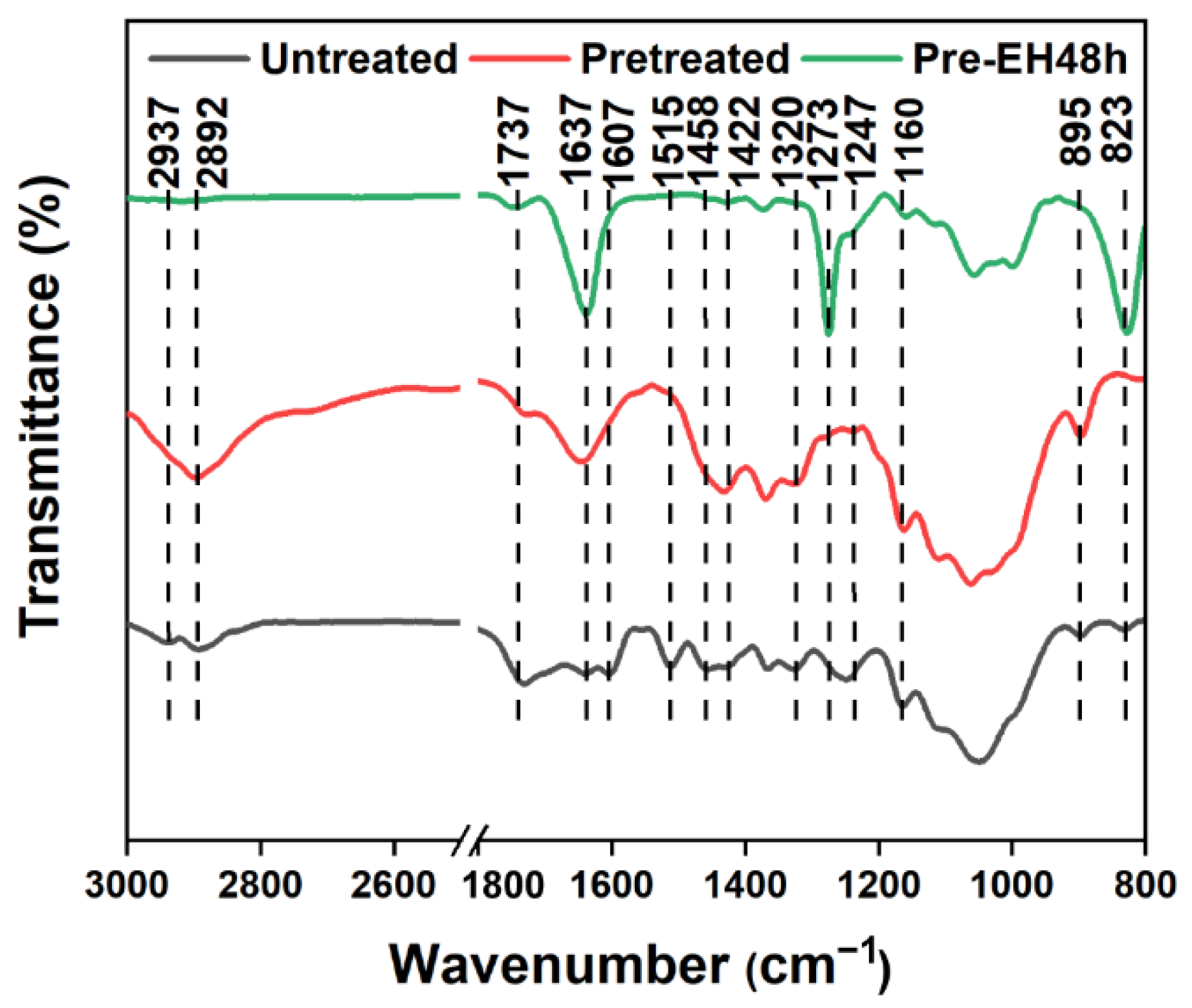

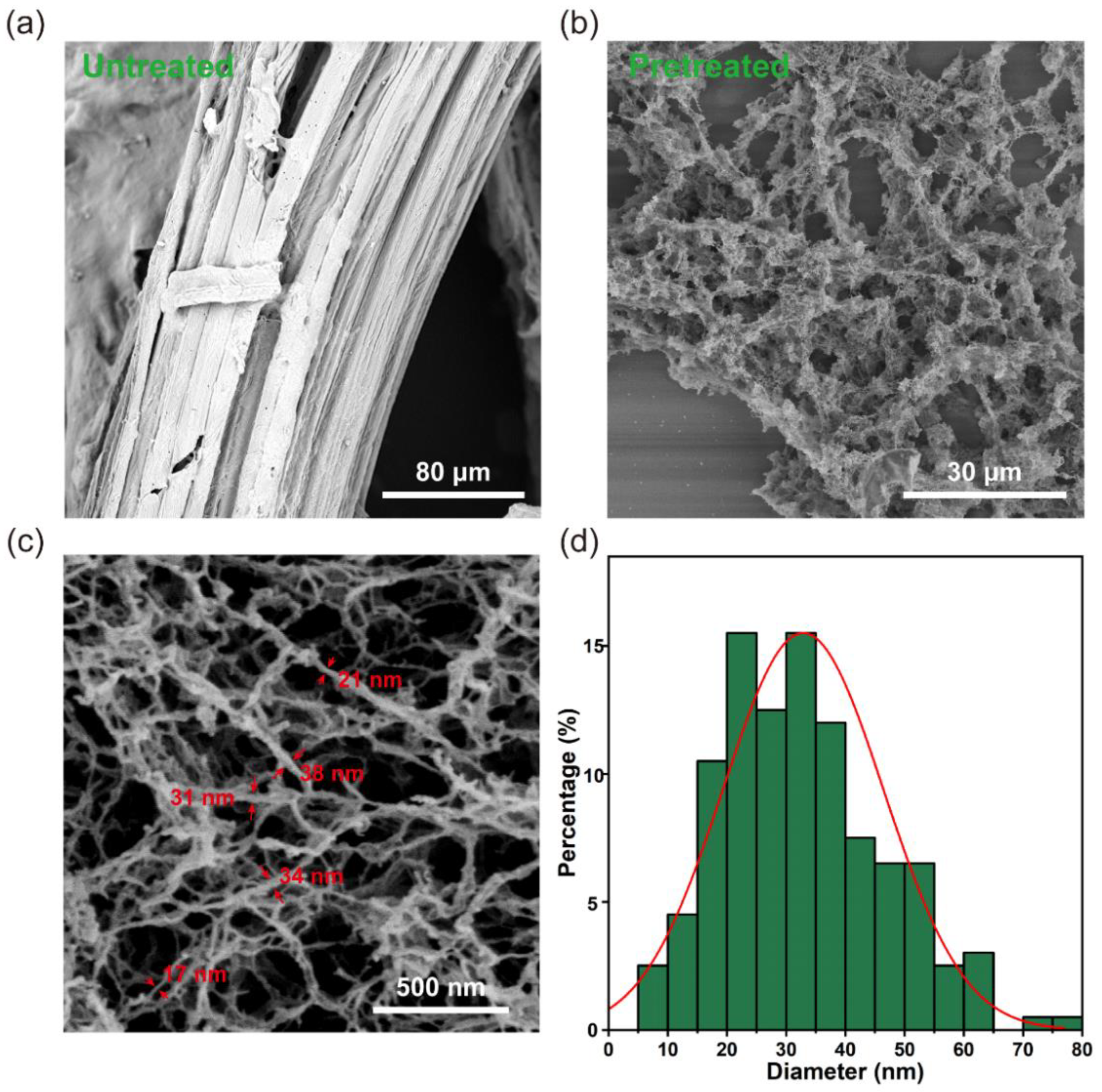
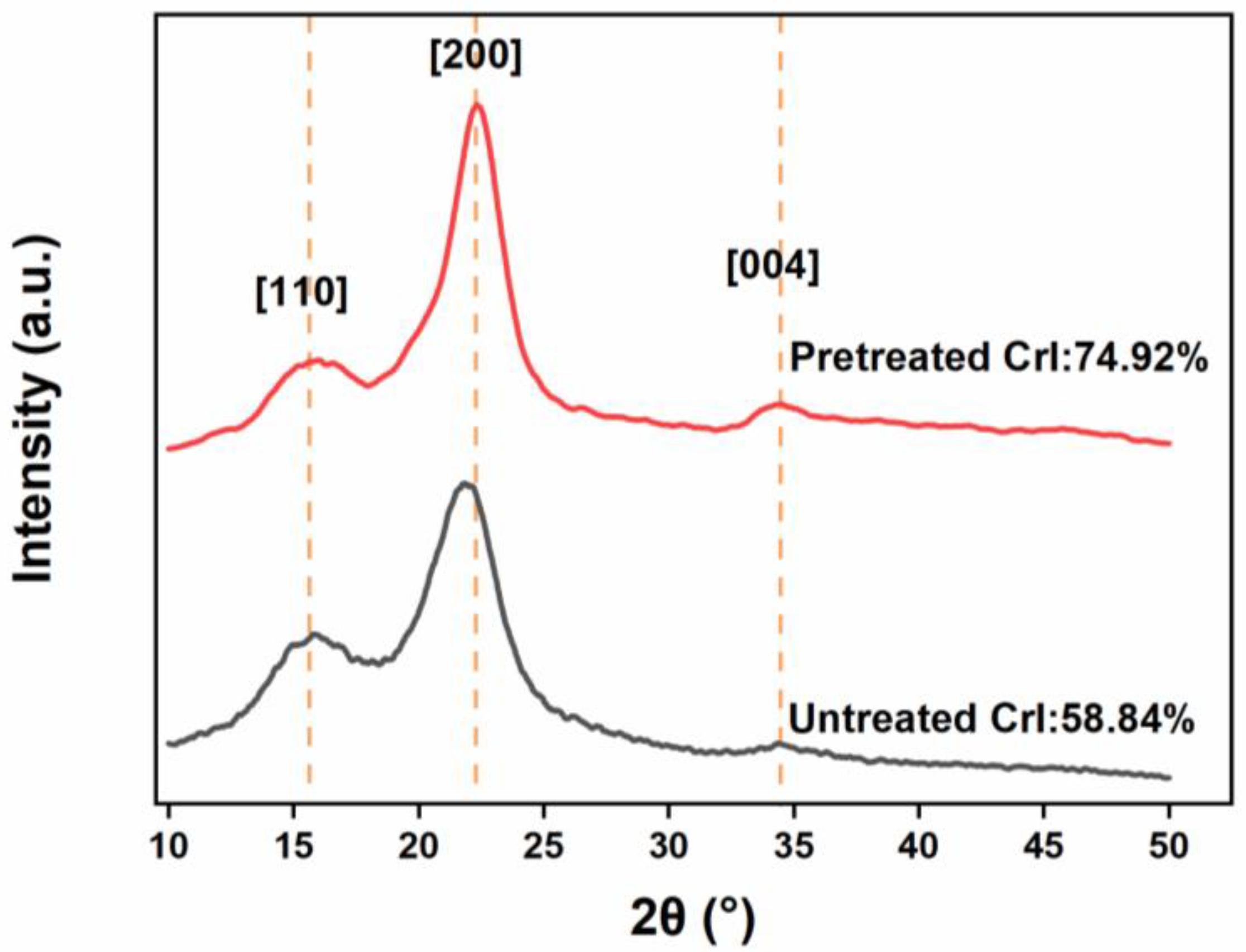
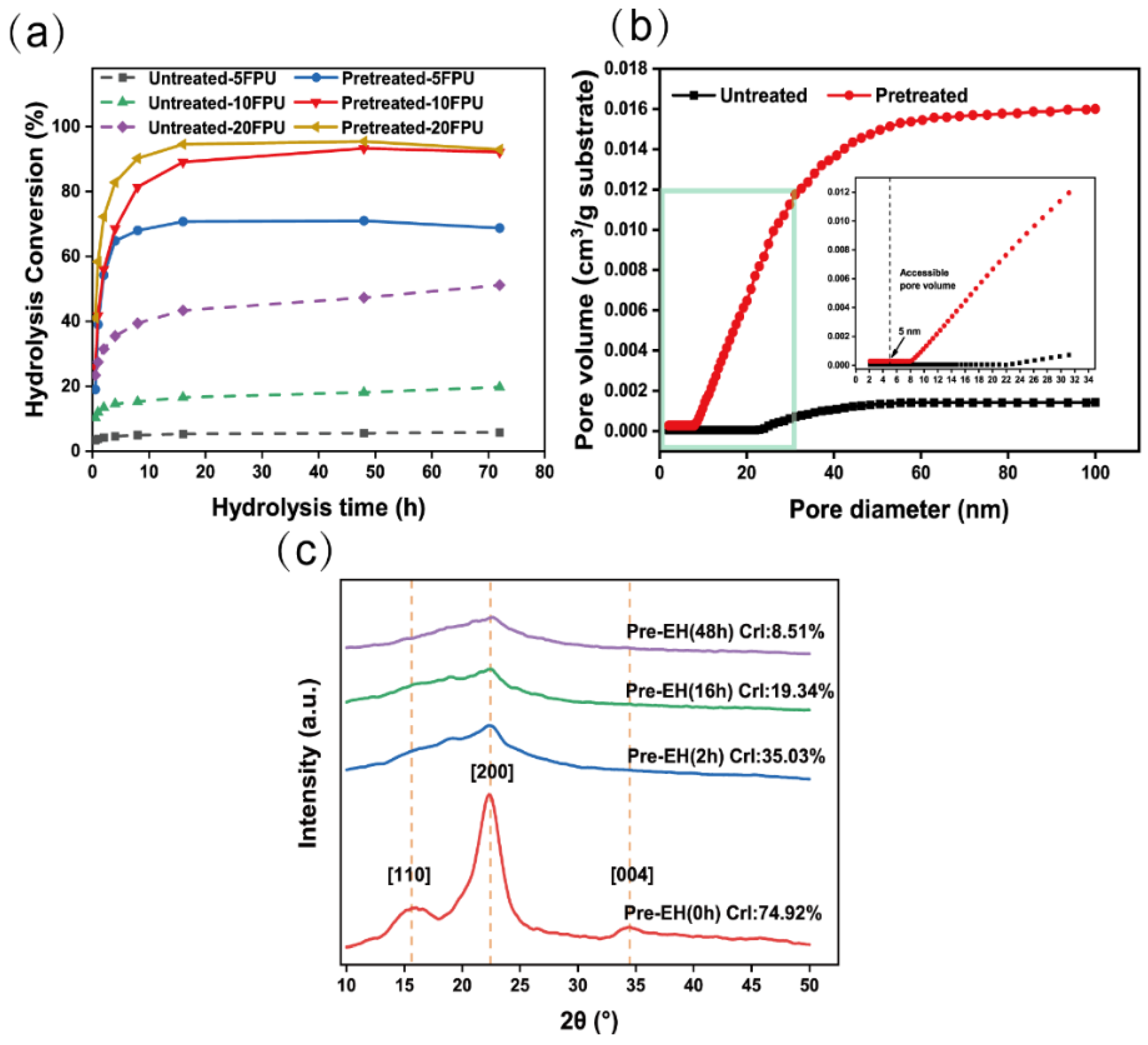
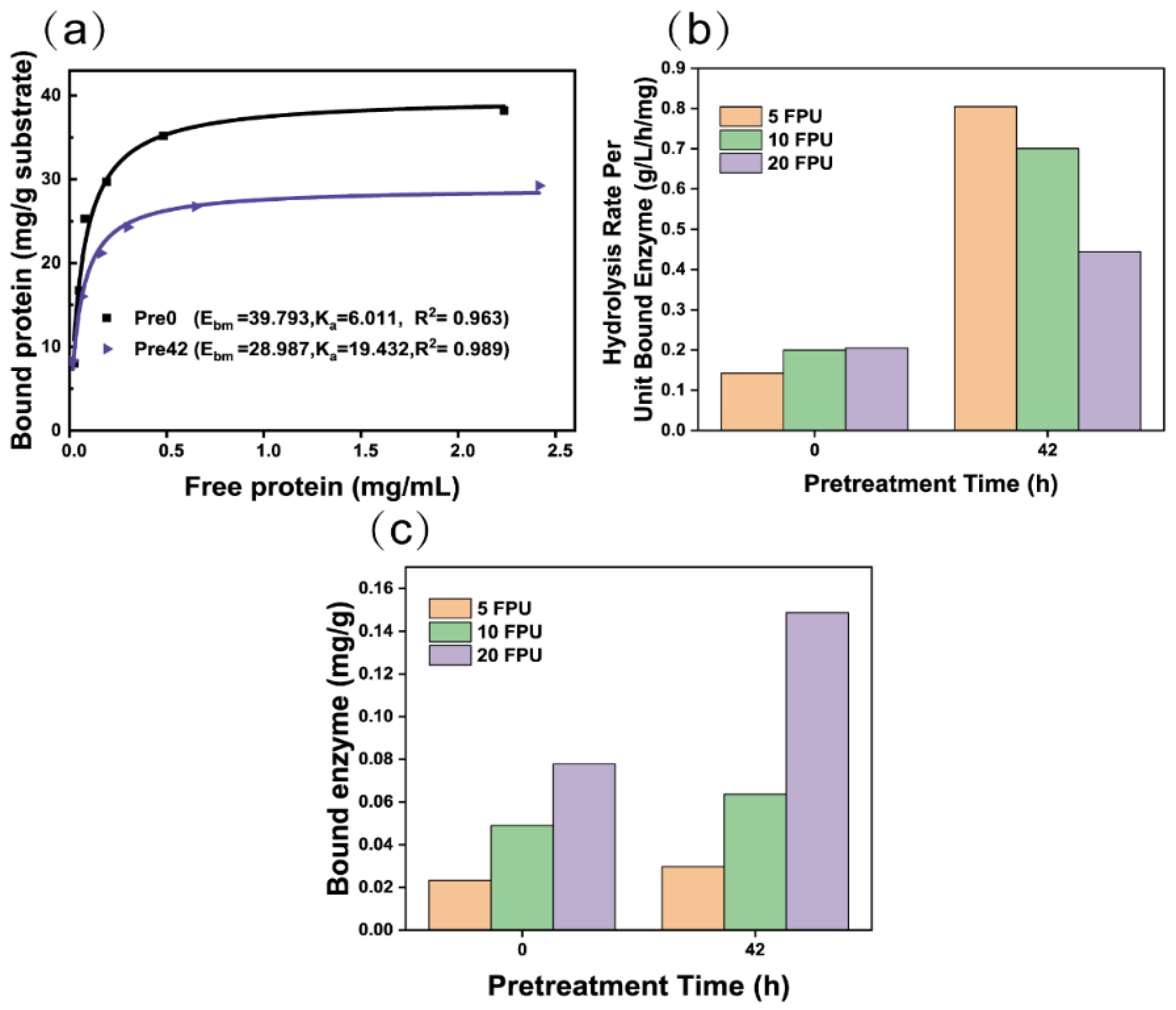

| Yield (%) a | Cellulose (%) | Hemicellulose (%) | Lingin (%) | |
|---|---|---|---|---|
| Untreated bagasse | 100/100 | 43.26 ± 2.13 | 22.86 ± 0.97 | 25.53 ± 1.18 |
| Pretreated bagasse | 42.58/96.03 | 97.56 ± 4.38 | 0 | 1.35 ± 0.11 |
| SSA (m2/g) | DPn | Zeta Potential (mV) | |
|---|---|---|---|
| Untreated bagasse | 0.3633 ± 0.016 | 2876.95 ± 26.83 | −9.01 ± 0.59 |
| Pretreated bagasse | 1.9068 ± 0.207 | 300.6 ± 7.48 | −45.61 ± 1.13 |
Publisher’s Note: MDPI stays neutral with regard to jurisdictional claims in published maps and institutional affiliations. |
© 2022 by the authors. Licensee MDPI, Basel, Switzerland. This article is an open access article distributed under the terms and conditions of the Creative Commons Attribution (CC BY) license (https://creativecommons.org/licenses/by/4.0/).
Share and Cite
Bai, F.; Dong, T.; Zhou, Z.; Chen, W.; Cai, C.; Li, X. Enhancing for Bagasse Enzymolysis via Intercrystalline Swelling of Cellulose Combined with Hydrolysis and Oxidation. Polymers 2022, 14, 3587. https://doi.org/10.3390/polym14173587
Bai F, Dong T, Zhou Z, Chen W, Cai C, Li X. Enhancing for Bagasse Enzymolysis via Intercrystalline Swelling of Cellulose Combined with Hydrolysis and Oxidation. Polymers. 2022; 14(17):3587. https://doi.org/10.3390/polym14173587
Chicago/Turabian StyleBai, Feitian, Tengteng Dong, Zheng Zhou, Wei Chen, Chenchen Cai, and Xusheng Li. 2022. "Enhancing for Bagasse Enzymolysis via Intercrystalline Swelling of Cellulose Combined with Hydrolysis and Oxidation" Polymers 14, no. 17: 3587. https://doi.org/10.3390/polym14173587
APA StyleBai, F., Dong, T., Zhou, Z., Chen, W., Cai, C., & Li, X. (2022). Enhancing for Bagasse Enzymolysis via Intercrystalline Swelling of Cellulose Combined with Hydrolysis and Oxidation. Polymers, 14(17), 3587. https://doi.org/10.3390/polym14173587






